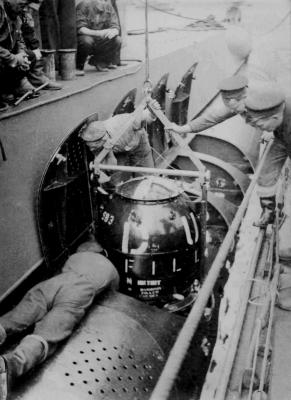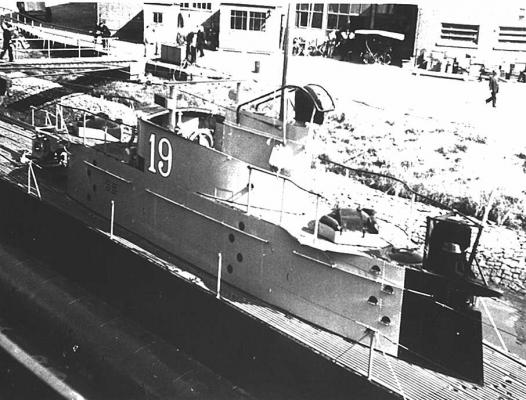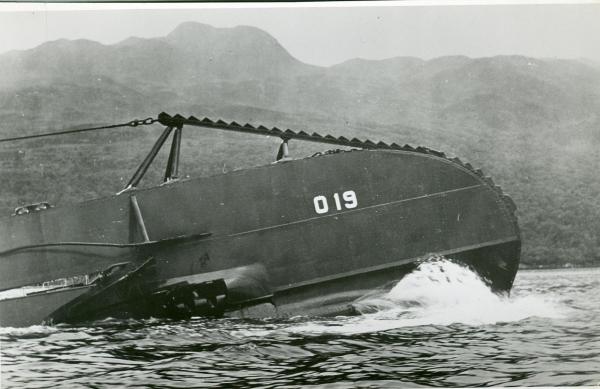
Gino den Ridder
Members-
Posts
12 -
Joined
-
Last visited
-
 Gino den Ridder reacted to a post in a topic:
Hr. Ms. O 19 by Piet - 1939 - 1945, scale 1:50, submarine Royal Navy Netherlands - Finished
Gino den Ridder reacted to a post in a topic:
Hr. Ms. O 19 by Piet - 1939 - 1945, scale 1:50, submarine Royal Navy Netherlands - Finished
-
 Gino den Ridder reacted to a post in a topic:
Hr. Ms. O 19 by Piet - 1939 - 1945, scale 1:50, submarine Royal Navy Netherlands - Finished
Gino den Ridder reacted to a post in a topic:
Hr. Ms. O 19 by Piet - 1939 - 1945, scale 1:50, submarine Royal Navy Netherlands - Finished
-
 Gino den Ridder reacted to a post in a topic:
Hr. Ms. O 19 by Piet - 1939 - 1945, scale 1:50, submarine Royal Navy Netherlands - Finished
Gino den Ridder reacted to a post in a topic:
Hr. Ms. O 19 by Piet - 1939 - 1945, scale 1:50, submarine Royal Navy Netherlands - Finished
-
 Gino den Ridder reacted to a post in a topic:
Hr. Ms. O 19 by Piet - 1939 - 1945, scale 1:50, submarine Royal Navy Netherlands - Finished
Gino den Ridder reacted to a post in a topic:
Hr. Ms. O 19 by Piet - 1939 - 1945, scale 1:50, submarine Royal Navy Netherlands - Finished
-
 Gino den Ridder reacted to a post in a topic:
Hr. Ms. O 19 by Piet - 1939 - 1945, scale 1:50, submarine Royal Navy Netherlands - Finished
Gino den Ridder reacted to a post in a topic:
Hr. Ms. O 19 by Piet - 1939 - 1945, scale 1:50, submarine Royal Navy Netherlands - Finished
-
 Gino den Ridder reacted to a post in a topic:
Hr. Ms. O 19 by Piet - 1939 - 1945, scale 1:50, submarine Royal Navy Netherlands - Finished
Gino den Ridder reacted to a post in a topic:
Hr. Ms. O 19 by Piet - 1939 - 1945, scale 1:50, submarine Royal Navy Netherlands - Finished
-
 Gino den Ridder reacted to a post in a topic:
Hr. Ms. O 19 by Piet - 1939 - 1945, scale 1:50, submarine Royal Navy Netherlands - Finished
Gino den Ridder reacted to a post in a topic:
Hr. Ms. O 19 by Piet - 1939 - 1945, scale 1:50, submarine Royal Navy Netherlands - Finished
-
 Gino den Ridder reacted to a post in a topic:
Hr. Ms. O 19 by Piet - 1939 - 1945, scale 1:50, submarine Royal Navy Netherlands - Finished
Gino den Ridder reacted to a post in a topic:
Hr. Ms. O 19 by Piet - 1939 - 1945, scale 1:50, submarine Royal Navy Netherlands - Finished
-
 Gino den Ridder reacted to a post in a topic:
Hr. Ms. O 19 by Piet - 1939 - 1945, scale 1:50, submarine Royal Navy Netherlands - Finished
Gino den Ridder reacted to a post in a topic:
Hr. Ms. O 19 by Piet - 1939 - 1945, scale 1:50, submarine Royal Navy Netherlands - Finished
-
 Gino den Ridder reacted to a post in a topic:
Hr. Ms. O 19 by Piet - 1939 - 1945, scale 1:50, submarine Royal Navy Netherlands - Finished
Gino den Ridder reacted to a post in a topic:
Hr. Ms. O 19 by Piet - 1939 - 1945, scale 1:50, submarine Royal Navy Netherlands - Finished
-
 Piet reacted to a post in a topic:
Hr. Ms. O 19 by Piet - 1939 - 1945, scale 1:50, submarine Royal Navy Netherlands - Finished
Piet reacted to a post in a topic:
Hr. Ms. O 19 by Piet - 1939 - 1945, scale 1:50, submarine Royal Navy Netherlands - Finished
-
Hi Piet, I found this one: De geus: 1º. de geus is een rechthoekige vlag, waarvan de lengte zich verhoudt tot de breedte als 3:2, verdeeld in sectoren in de kleur van de koninkrijksvlag; 2º. de geus wordt uitsluitend door oorlogsschepen in dienst gevoerd en wel aan de geusstok; 3º. zij voeren de geus alleen wanneer zij in een haven of op een rede gemeerd of ten anker liggen For the non-dutch (freely translated): The Jack, 1 The jack is a rectangular shaped flag, of which the length comapres to its breadth as 3:2, divided in sectors in the color of the Royal flag. 2 the jack is only flown on warships that are in-service on the jack mast. 3 they only fly the jack when in harbor, outside the harbor moored, or anchored. Groetjes
-
 Kevin reacted to a post in a topic:
Hr. Ms. O 19 by Piet - 1939 - 1945, scale 1:50, submarine Royal Navy Netherlands - Finished
Kevin reacted to a post in a topic:
Hr. Ms. O 19 by Piet - 1939 - 1945, scale 1:50, submarine Royal Navy Netherlands - Finished
-
 Kevin reacted to a post in a topic:
Hr. Ms. O 19 by Piet - 1939 - 1945, scale 1:50, submarine Royal Navy Netherlands - Finished
Kevin reacted to a post in a topic:
Hr. Ms. O 19 by Piet - 1939 - 1945, scale 1:50, submarine Royal Navy Netherlands - Finished
-
If the dingy (in Dutch: vlet, a dingy is made of rubber, and inflatable) was upside down then it would cause an air bubble to exist underneath. Now, I think that submariners don't like air bubbles to escape from their boat when submerged. Especially when 'the other party' is looking for them...
-
 Piet reacted to a post in a topic:
Hr. Ms. O 19 by Piet - 1939 - 1945, scale 1:50, submarine Royal Navy Netherlands - Finished
Piet reacted to a post in a topic:
Hr. Ms. O 19 by Piet - 1939 - 1945, scale 1:50, submarine Royal Navy Netherlands - Finished
-
 flying_dutchman2 reacted to a post in a topic:
Hr. Ms. O 19 by Piet - 1939 - 1945, scale 1:50, submarine Royal Navy Netherlands - Finished
flying_dutchman2 reacted to a post in a topic:
Hr. Ms. O 19 by Piet - 1939 - 1945, scale 1:50, submarine Royal Navy Netherlands - Finished
-
 mtaylor reacted to a post in a topic:
Hr. Ms. O 19 by Piet - 1939 - 1945, scale 1:50, submarine Royal Navy Netherlands - Finished
mtaylor reacted to a post in a topic:
Hr. Ms. O 19 by Piet - 1939 - 1945, scale 1:50, submarine Royal Navy Netherlands - Finished
-
Beautiful! Really a superb job! This is truly a museum piece, worthy of the fine crew that sailed her. May I suggest the deck gun for the next 'release'?... On a sadder note: the last officer to see the O19 as she was stuck on Ladd Reef with his own eyes, Frank Kimball of the USS Cod, passed away February 20th. Groetjes, Gino
-
 Piet reacted to a post in a topic:
Hr. Ms. O 19 by Piet - 1939 - 1945, scale 1:50, submarine Royal Navy Netherlands - Finished
Piet reacted to a post in a topic:
Hr. Ms. O 19 by Piet - 1939 - 1945, scale 1:50, submarine Royal Navy Netherlands - Finished
-
 PacificCrossRoads reacted to a post in a topic:
Hr. Ms. O 19 by Piet - 1939 - 1945, scale 1:50, submarine Royal Navy Netherlands - Finished
PacificCrossRoads reacted to a post in a topic:
Hr. Ms. O 19 by Piet - 1939 - 1945, scale 1:50, submarine Royal Navy Netherlands - Finished
-
 mtaylor reacted to a post in a topic:
Hr. Ms. O 19 by Piet - 1939 - 1945, scale 1:50, submarine Royal Navy Netherlands - Finished
mtaylor reacted to a post in a topic:
Hr. Ms. O 19 by Piet - 1939 - 1945, scale 1:50, submarine Royal Navy Netherlands - Finished
-
 avsjerome2003 reacted to a post in a topic:
Hr. Ms. O 19 by Piet - 1939 - 1945, scale 1:50, submarine Royal Navy Netherlands - Finished
avsjerome2003 reacted to a post in a topic:
Hr. Ms. O 19 by Piet - 1939 - 1945, scale 1:50, submarine Royal Navy Netherlands - Finished
-
The mine laying system was based on the French Normand-Fenaux system. This system has two mines in each tube. This system was safe and reliable, according to French naval records. A similar system was employed by the Germans in their UC1 class during WW1. (source: Submarine Operational Effectiveness in the 20th century: Part One (1900-1939) by Captain John F. O'connell) Also, check this link for the patent from Vickers for an equivalent mine laying system: http://www.google.com/patents/US1777416 Both systems dropped the mines from the tubes. It makes no sense to launch them upwards toward the surface. During the mine laying operation you don't want to run the risk of mines surfacing, or dropping back on your boat when the launching system malfunctions. Also, it would make the already cramped space for the mines even tighter when also a launch system has to be built in, together with the depth setting system.
-
Piet, I impressed! The green really makes the boat 'pop'. It looks great! To solve some mysteries... The mines were loaded from the top, and launched from the bottom. Of course this happened while submerged. One of the crew members once said that he was terrified during a mine laying operation; in shallow waters with all the noise they were making while dropping mines. Then, for the lettering...Check these photos: The boat at its commissioning in den Helder. Surfacing in 1943 (Loch Long) You can see that even during the war the O19 lettering on the bow was still present! Hope that helps, Groetjes, Gino
-
One thing is certain, if the O19 had its bell on Ladd reef, then it's still there (provided that scavengers haven't wrecked the place by now...) There is no record of it being taken of the boat to the USS Cod. There was some other stuff taken, which is now in the possession of the US Cod Submarine Memorial in Cleveland, OH. As far as I know, US submarines left their bell in port during WW2, when they went on patrol. That's why you may see some of them still being used during a 'tolling of the bells' ceremony, which is to commemorate those submariners that are 'still on patrol'. Let me also get confirmation on that. Groetjes,
-
Piet as usual your doing great there. I'm astonished about the amount of detail you are putting in her. Like I said before your model already looks better than the original model from the shipyard. @harvy1847 Th photo you show us here was made after the refit, and modifications in the UK in 1943. If you compare the photo with Piet's model, you will see that the front part of the conning tower has changed. The front AA gun had been removed. Probably because that whole section caused too much drag. @Sailor1234567890 This actually was common practice for pre-war subs. Even the American fleetsubs had a helm on the bridge. Also if you look closely to early German subs you'll find the helm on the bridge. However, the German subs didn't have a wheel, but push buttons. On the US subs the helm on the bridge was removed when the whole conning towers were reconstructed, from a closed bridge to an open on. One less man on the bridge means faster dive times. That's why the helm on the bridge disappeared...
-
Boris, I strongly doubt that the side panels for the swivel torpedo tube opened the way you show here. From the very few photos of the O16, as far as I have checked, the panels dropped down, just as on O19. It doesn't make sense to pull the panels open against water pressure, with the risk of having them not open at all. By dropping them, the water pressure would help opening them, thus reducing the risk. Groetjes, Gino
-
Hoi Peter, Starts looking wonderful. I don't want to burst your bubble, but the deck torpedo tubes are longer than the boat is wide. This means that if you want to swivel the tubes both side panels had to be open... Here's a picture of O20 with her decktubes ready to launch. According to the drawing (the one I'm 're-doing') the decktubes are between 92-93 and 103-104 meters from the aft of the boat. Is that then 'dividing by 50? Groetjes, Gino
-
@Freek, Dutchsubmarines is wrong on that. The O19's tubes were 4 bow tubes, two tubes aft and 2 deck tubes. The decktubes could be swiveled out, thus giving the advantage that, although the tracks (bubbles) of the torpedoes could be traced back to their origin (i.e. the boat) the course of the boat would be already 90 degrees from the torpedo course. This French invention was successfully used in the early war years in the Pacific. O19 was refitted in the UK (Dundee, Scotland). She never was in the US. Photos taken on Ladd reef show the deck tubes swiveled out to 90 degrees, with two crew members on top. See attached. This was done to empty them, and thus make the boat lighter. About how they worked, check this: You'll need to be able to read Dutch for this. It's a drawing from an 'Oh Ja' booklet made by a crew member of the O19. This booklet is in the archives of the Dutch Navy Museum in den Helder. Groetjes, Gino
-
Piet, The deck torpedo tubes weren't removed from the O19 in 1943. Pictures taken on Ladd reef show that the tubes were still there. Furthermore, on of the photos show that they were swiveled out, so the mechanism underneath (known as the Christmas tree) wasn't removed. It was a source of nuisance for the crew, since apparently it was always leaking when in use.It could be that it was more or less de-activated in the 1943 maintenance. The tables inside the O19 were, as far as I can find, part of the boat. There are photographs of a Christmas party being held inside the boat, at which crew members sit at a table. whether or not it was collapsible I can't say, but there is a high probability that they were. Groetjes, Gino
About us
Modelshipworld - Advancing Ship Modeling through Research
SSL Secured
Your security is important for us so this Website is SSL-Secured
NRG Mailing Address
Nautical Research Guild
237 South Lincoln Street
Westmont IL, 60559-1917
Model Ship World ® and the MSW logo are Registered Trademarks, and belong to the Nautical Research Guild (United States Patent and Trademark Office: No. 6,929,264 & No. 6,929,274, registered Dec. 20, 2022)
Helpful Links
About the NRG
If you enjoy building ship models that are historically accurate as well as beautiful, then The Nautical Research Guild (NRG) is just right for you.
The Guild is a non-profit educational organization whose mission is to “Advance Ship Modeling Through Research”. We provide support to our members in their efforts to raise the quality of their model ships.
The Nautical Research Guild has published our world-renowned quarterly magazine, The Nautical Research Journal, since 1955. The pages of the Journal are full of articles by accomplished ship modelers who show you how they create those exquisite details on their models, and by maritime historians who show you the correct details to build. The Journal is available in both print and digital editions. Go to the NRG web site (www.thenrg.org) to download a complimentary digital copy of the Journal. The NRG also publishes plan sets, books and compilations of back issues of the Journal and the former Ships in Scale and Model Ship Builder magazines.






